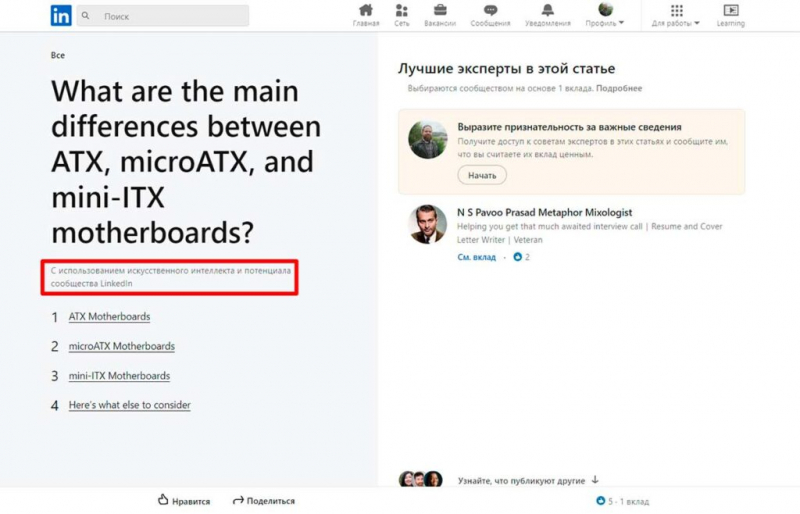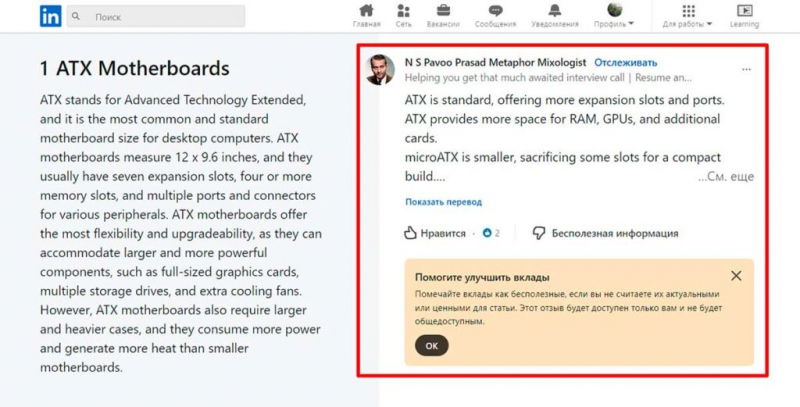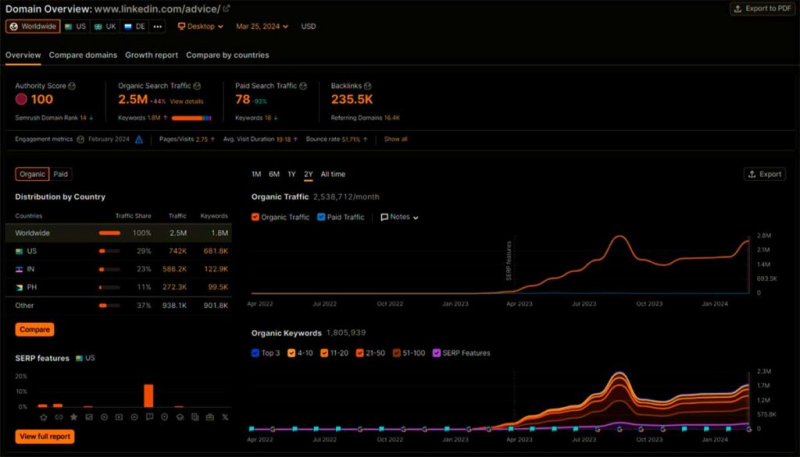In 1 year, the LinkedIn project “Collective Articles” has reached the mark of 10 million pages of expert content. Since September 2023, their regular audience has increased by more than 270%.
The way the project has achieved its current performance, and is likely to continue its rapid growth in the future, allows you and me to learn valuable lessons to create our own SEO strategy using AI in conjunction with the expertise of living people.

Recommendation of the month: Telega.in — a platform for native integrations in Telegram channels. Manually verified channels and bots. We help you find your target audience in Telegram and launch effective integrations.
- Why do Collective Articles work
- How LinkedIn created 10 million pages of expert content
- Experience, expertise, credibility and credibility
- Main SEO conclusions
Why do Collective Articles work
The idea behind the Collaborative Articles project is that people turn to the Internet to understand certain (subject) topics, but what is on the Internet does not always turn out to be useful information from real experts in a particular field.
Usually, a person searches for information on Google, gets to a site like Picaboo or Reddit, and reads what is posted there. But in this case, there is no certainty that this information belongs to an expert from a certain field, and not just an ordinary chatterbox (or a CPA webmaster).
How can a person who is not an expert in the topic know that a stranger’s message is trustworthy and expert?
The solution to the problem was to involve LinkedIn experts to create articles on topics in which they are experts. As a result, such pages are ranked in Google, and this benefits the expert, which in turn motivates the expert to write more content.

How LinkedIn created 10 million pages of expert content
LinkedIn identifies experts in a particular field and asks them to write an essay on a given topic. The essay topics are generated using an artificial intelligence tool developed by the LinkedIn editorial team. These topics are then compared with the experts in the subject area identified using the LinkedIn Skills Graph.
The LinkedIn Skills Graph matches LinkedIn members with domain experts using a framework called Structured Skills, which uses machine learning models and natural language processing to identify related skills beyond those defined by community members themselves.
The comparison uses skills found in user profiles, job descriptions, and other textual data on the platform. As a starting point.
Next, artificial intelligence, machine learning and natural language processing are used to gain additional knowledge and experience that users can have.
The Skills Graph documentation explains all this as follows:
If a member of the community knows about artificial neural networks, then he knows something about deep learning, which means that he knows something about machine learning.
…Our machine learning and artificial intelligence comb through huge amounts of data and offer new skills and connections between them.
In combination with natural language processing, we extract skills from many different types of text with a high degree of confidence to ensure high coverage and high accuracy when matching skills with our users…

Experience, expertise, credibility and reliability
The strategy behind LinkedIn’s Collective Articles project is ingenious, because the result is millions of pages of high-quality content from specialized experts on millions of topics. Perhaps this is why LinkedIn pages are getting more and more organic impressions in Google search.
Now LinkedIn is improving its project by adding features to it that should further improve the quality of pages:
- The evolution of the way of asking questions. Recently, LinkedIn has been presenting experts with scenarios on which they can write essays that touch on real topics and questions.
- The “Useless information” button. Collective articles have a button with which readers can tell LinkedIn that a specific addition from an expert is not useful. From an SEO perspective, it’s very interesting that LinkedIn views the Reject button through a utility paradigm.
- Improved algorithms for selecting topics. LinkedIn has improved the algorithm for selecting users for topics, which is called “Embedding Based Retrieval For Improved Matching” (“Embedding-based search to improve matching”) and was created taking into account user feedback on the quality of matching topics to users.
Explanation from LinkedIn:
Based on the feedback from our users obtained through special evaluation mechanisms, we have focused our efforts on the possibilities of comparing articles and expert users. One of the new methods we are using is the embedding-based search (EBR). This method generates intersperses for participants and articles in the same semantic space and uses an approximate search for the nearest neighbors in this space to generate the best matches of articles for community members.

The main SEO conclusions
“Collective Articles” from LinkedIn is one of the best strategic content creation projects that I have seen recently. What makes it revolutionary is that it uses artificial intelligence and machine learning technologies together with human experience to create expert and useful content that readers like and can trust.
LinkedIn uses user interaction signals to improve the quality of experts invited to create articles, as well as to identify articles that do not meet the needs of users.
The advantages of such article creation are that highly qualified profile specialists are promoted every time their article gets into the Google search results, which gives anyone who promotes a service, product or is looking for clients or the next job an opportunity to demonstrate their skills, experience and credibility.
